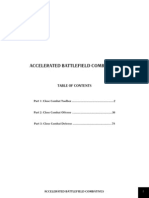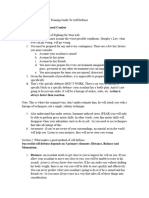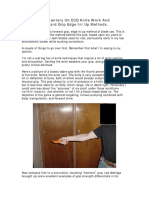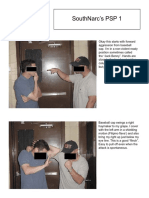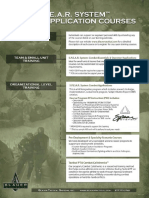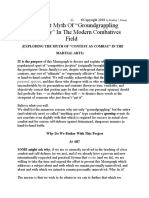100%(1)100% found this document useful (1 vote)
396 viewsCestari Eng
Cestari Eng
Uploaded by
carotino63The document summarizes the contents and techniques taught on two training tapes about unarmed combat by Carl Cestari. Tape 1 covers fundamentals like attacking an opponent's balance by targeting the head and legs, as well as blows like the edge of hand, axe hand, and heel of hand strikes. Cestari emphasizes delivering fast, aggressive combinations of attacks and maintaining distance from opponents. Tape 2 (summarized briefly) focuses on "lesser known blows" and advanced striking techniques.
Copyright:
© All Rights Reserved
Available Formats
Download as TXT, PDF, TXT or read online from Scribd
Cestari Eng
Cestari Eng
Uploaded by
carotino63100%(1)100% found this document useful (1 vote)
396 views7 pagesThe document summarizes the contents and techniques taught on two training tapes about unarmed combat by Carl Cestari. Tape 1 covers fundamentals like attacking an opponent's balance by targeting the head and legs, as well as blows like the edge of hand, axe hand, and heel of hand strikes. Cestari emphasizes delivering fast, aggressive combinations of attacks and maintaining distance from opponents. Tape 2 (summarized briefly) focuses on "lesser known blows" and advanced striking techniques.
Original Description:
Article to Carl Cestari
Copyright
© © All Rights Reserved
Available Formats
TXT, PDF, TXT or read online from Scribd
Share this document
Did you find this document useful?
Is this content inappropriate?
The document summarizes the contents and techniques taught on two training tapes about unarmed combat by Carl Cestari. Tape 1 covers fundamentals like attacking an opponent's balance by targeting the head and legs, as well as blows like the edge of hand, axe hand, and heel of hand strikes. Cestari emphasizes delivering fast, aggressive combinations of attacks and maintaining distance from opponents. Tape 2 (summarized briefly) focuses on "lesser known blows" and advanced striking techniques.
Copyright:
© All Rights Reserved
Available Formats
Download as TXT, PDF, TXT or read online from Scribd
Download as txt, pdf, or txt
100%(1)100% found this document useful (1 vote)
396 views7 pagesCestari Eng
Cestari Eng
Uploaded by
carotino63The document summarizes the contents and techniques taught on two training tapes about unarmed combat by Carl Cestari. Tape 1 covers fundamentals like attacking an opponent's balance by targeting the head and legs, as well as blows like the edge of hand, axe hand, and heel of hand strikes. Cestari emphasizes delivering fast, aggressive combinations of attacks and maintaining distance from opponents. Tape 2 (summarized briefly) focuses on "lesser known blows" and advanced striking techniques.
Copyright:
© All Rights Reserved
Available Formats
Download as TXT, PDF, TXT or read online from Scribd
Download as txt, pdf, or txt
You are on page 1of 7
At a glance
Powered by AI
The tapes discuss close combat techniques focusing on attacking vulnerable areas like the head, throat, groin and legs using blows, joint locks and throws to disrupt an opponent's balance and ability to defend themselves.
Some of the main targets discussed are the eyes, throat, groin, knees, shins and insteps. Techniques demonstrated include blows like the edge of hand, elbows, headbutts and joint locks/throws targeting the legs.
Cestari emphasizes launching a full assault of combined blows and kicks against an opponent and to never let them get close or allow time to defend. He stresses attacking first and maintaining aggression through a 'battery' of attacks.
Tape 1: Fundamentals of Unarmed Combat.
Tape 2: Lesser Known Blows of Close Combat. (Advanced Strike's)
Each tape is approximately 55 minutes long.
I'm going to go into more details than I normally would in a video review, since
these tapes have been unavailable for some time. There is more in the series bu
t these are all I have.
TAPE 1: Fundamentals of Unarmed Combat.
Cestari begins this tape by addressing Distance, Momentum, and Balance.
Attacking the head/neck area or the legs most effectively disrupts an opponent's
balance. Cestari explains the correct line of force to disrupt the persons bala
nce is always indicated by a perpendicular line intersecting an imaginary line c
onnecting their two feet. Straight front push or pull when someone is in a full
frontal position parallel. Zone 45 degrees for someone in a foot-forward ready p
osition, to attack their balance. Cestari then demonstrates attacking the head a
nd legs by doing a head twist takedown, then by demonstrating a reaping leg-swee
p, both against a strong stance. He explains that these takedowns are just for d
emonstrating the principle of attacking the head & legs; Close Combat relies mor
e on blows.
Torso blows are discouraged for the simple reasons that extensive training is re
quired for them to be effective, and even then their effectiveness can be obviat
ed by clothing, etc. Close Combat always assumes the worst possible conditions;
targets should be the head, throat, groin, and legs.
Head & neck targets include eyes, bridge of nose and base of nose, point of chin
, temples, line of the jaw, larynx, carotids, and mastoid areas. Blows to the le
gs include kicks and stomps to the thighs, knees, shins, and insteps. The level
of damage inflicted on these areas by close combat blows is determined by the fo
rce and repetition of these blows. This is all explained in more detail when dea
ling with each specific blow.
Cestari stresses that the opening move is like the gambit in chess. It has to be
a strong move followed through with non-specific flowing attack. There are no d
efensive moves in close combat.
In dealing with Distance, Cestari stresses that you should never let a doubtful
person close enough to jam your attack. Action is always faster than reaction so
attack first when someone is closing in on you. Once within range there is no w
ay to defend against non-telegraphic blows. Especially when followed through wit
h a battery of combination attacks. Cestari stresses the importance of deliverin
g a battery of attacks. Even if they successfully defend against your first blow
there is no way they can defend against a full on assault of combined blows and
kicks. Attack and keep attacking.
Maintain awareness. Don't let anyone get close. If they approach you, reestablis
h distance. This negates his ability to strike without committing body weight to
close the distance, and telegraphing his attack. An opponent only has 3 options
. 1) to stay where he is, 2) attack, and 3) leave. If he leaves, maintain awaren
ess of your surroundings until you are safe. If he stays, attack him first, by s
taying he is indicating his intent to attack, so you must make the preventative
attack. ATTACK him if he does not leave.
If he approaches you to attack, maintain distance by zoning 45 degrees whenever
possible. This may not be possible in a hallway or other confining circumstance.
Zoning makes him have to adjust his position before attacking giving you a slig
ht window in timing to launch your attack.
Maintain your hips and shoulders at an angle (45 degrees) ready position wheneve
r possible, for balance and protecting your vital areas. Maintain stability with
your weight on your front leg leaning into his approach, also to move under his
strikes.
Cestari stresses keeping the body tense. Train in stiff, gross body motion. You
are going to be tense anyway, so train for it.
The enemy can be in front of you in 3 possible positions; 1) left foot forward,
2) right foot forward, and 3) feet parallel. Always enter along his weakest line
of balance as explained before.
Blows
Edge of Hand Blow.
This is executed by snapping the hand open in a convulsive manner, open tight fo
r the blow. Deliver the blow from whatever position you are in straight to the t
arget without chambering or telegraphing. In training practice delivering the bl
ow directly from a variety of awkward, inconvenient, or likely positions.
In close quarters power is generated through the drop step. From a ready stance
with your weight on your front leg, lift the front leg and step INTO the strike,
your blow hitting with your weight behind it before your foot hits the floor.
Cestari emphasizes that close combat footwork is ALL stomping, including the dro
p step. Stomping is intimidating, and is the best for uneven terrain, cluttered
terrain, ice, snow, mud, etc. There is no sliding or shuffling footwork in close
combat. With the dropstep STOMP INTO the blow, large heavy movement, gross moto
r skills.
Cestari teaches in the initial confrontation to assume a non-aggressive prepared
stance that positions your hands ABOVE the assailant's hands. Ready positions o
f the hands include; folded at belt, folded at chest, jack benny stance, hands r
aised by head/shoulder. And a ready boxing-like stance, hips & shoulders at a 45
degree angle to the assailant, hands open in ax-hand position.
From a hands folded at belt ready position, Cestari demonstrates the blow delive
red in a straight line directly to target (throat) with the dropstep. The edge o
f hand lands before the foot. All of the bodyweight goes into the strike deliver
ed in one convulsive snapping motion.
This is also demonstrated from a 45 degree ready position with the forehead poin
ted down toward the opponents chest, below his shoulder level, putting your weig
ht into the blow. This protects your head against his counterblows and allows yo
u to move up into more attacks.
From wherever you are standing the blow is delivered in a straight line into a s
napping convulsive attack to the target.
After the first blow continue short axe hand blows, snapping from elbows. Massiv
e damage is inflicted from repeated fast snapping blows to the target. After the
initial assault blows can be chambered for more power. The "short" axe hand sna
ps from the elbow. The "long" axe hand is like a saber, a wide powerful arc.
At this juncture Cestari explains the three ways a blow traumatizes the head:
1. Direct trauma at point of impact to the target area.
2. Referred trauma to the brain from impact.
3. Trauma to the cervical vertebrae (whiplash).
Cestari breaks the ax-hand technique down into a three part progression:
1. The initial drop-step axe-hand.
2. Short axe-hand. Multiple snapping attack delivered from elbow.
3. Long axe-hand. Wide arc powershot.
The virtues of the axe-hand blow include its efficiency, little training necessa
ry, and the blow can be delivered with power without damaging the hand.
Up to this point Cestari has demonstrated the horizontal axe hand. Now he moves
on to the vertical axe hand.
The vertical axe-hand follows the same three part progression. Dropstep with you
r body weight into the blow VAH to the neck, jaw, temple. Do not telegraph the b
low by chambering behind your body.
Cestari stresses NEVER to depend on single blows, no matter how hard or effectiv
e you hit. One blow should be five or six in an aggressive battery attack. When
explaining this, Cestari demonstrates a rapid combination attack. Let there be n
o doubt; CESTARI IS FAST AND FURIOUS. The quality of instruction is exceeded onl
y by the explicit level of skill demonstrated by Cestari on these tapes.
The short hacking vertical axe-hand is demonstrated next. All blows are used in
conjunction with other blows and kicks.
The long vertical axe-hand is then demonstrated against an opponent that is bent
over. Blows delivered to the back of the neck, spine, and kidneys.
Cestari demonstrates his counter to an opponent chambering for a sucker-punch ty
pe attack; hit their shoulder as they are chambering and stay on them with an ag
gressive assault.
Heel of Hand Blow.
The heel of hand blow can be delivered to any area of the skull. It is most effe
ctive when used with the fingers gouging the eyes. If for whatever reason the bl
ow is not effective the fingers can still dig and gouge the eyes.
Again Cestari stresses training to deliver direct blows from inconvenient positi
ons, such as with your hands in your pockets, behind your back, behind your head
, etc.
Cestari breaks the Heel of Hand blow into a 2 part progression.
1. Direct Chin Jab. Body weight thrown into blow, following through with eye cla
ws.
2. Uppercut chin jab. Step to side, shoulder/hip aligned to his centerline, blow
delivered with forearm slam to sternum, upward into chin-jab, then driving with
fingers into eyes, driving face back and down.
If you can pin his back with the other hand the force of the blow will also trau
matize the spine.
The Heel of Hand blow is demonstrated against any area of the face; cheekbones,
eyes, fits into the nooks and crannies of the skull, and also very effective to
the back of skull.
Cestari wraps up the first video with a brief statement about the realities of c
lose combat. Always assume the worst conditions, poor visibility, etc. Your targ
et will be about as specific as a silhouette. The effective simple basic methods
of hand to hand combat are the best and most reliable. Close combat is not a sp
ort, and is not sport as combat. Close combat has a proven track record. No flas
h. SMASH THEM INTO THE GROUND.
I'll post shortly with a review/breakdown of tape #2, then #3.
--------------------------------------------------------------------------------
------------------------------
TAPE 2: Lesser Known Blows (Advanced Strike's) of Close Combat by Carl Cestari.
Cestari cuts to the chase, stating that the blows of close combat are meant to m
inimize damage to the fist; the reason why closed-fist boxing blows are not in t
he corpus of close combat methods.
Web of Hand Blow.
The first blow demonstrated and explained is the web of hand blow. The first dem
onstration is a direct drop-step, twisting into a web-hand blow to the throat, f
ollowing through with the body weight. Again, Cestari stresses following through
with a battery of attacks, keeping forward momentum. The web-hand blow to the t
hroat can stun or kill depending on the force of the blow.
You can also use strikes to the head, such as the chin-jab, to knock the head ba
ck opening the throat for a web-hand blow to the trachea.
Striking with the web-hand to the side of the neck, to the carotid area allows t
he thumb to hook into the larynx or jugular notch, but only as adjunct to other
blows. Again, Cestari stresses NEVER to rely on single blows in close combat. AL
WAYS follow through with a battery of attacks.
Cestari then demonstrates other applications of the web-hand blow. Web-hand to t
he base of the nose, and then to the back of the skull to stun and control by gr
abbing the neck to control someone in the event that it is possible, or if you h
ave to for some reason. This is especially addressed to Law Enforcement Officers
.
Double Chin Jab
This is one of my favorite techniques on the tape. Performed just as the heel of
palm chin-jab, only using both hands. Move straight into attack with the drop-s
tep, clawing fingers into the eyes. Cestari mentions that this was a favorite of
Fairbairn, especially when teaching women because of the power and damage even
a person of small-stature can inflict with this blow.
Next Cestari demonstrates the double chin-jab in conjunction with driving the kn
ee into the groin. This is followed by a double chin-jab to the face and nose, d
riving the thumbs into the eyes. This is followed by a double chin-jab, then dro
pping to the throat with the thumbs driving into the jugular notch. All brutal a
nd effective techniques.
Hammerfist
Cestari explains the proper way to clench the fist for the hammerfist blow. TIGH
TLY close your pinky first, then fingers, then thumb. All TIGHTLY. The point of
application of the hammerfist is either at the bend of the base knuckle and the
lower part of the pinky, or at the meat of the fist.
The hammerfist is applied much like the axe-hand. Straight in with drop-step to
target. With a short chop from the elbow. Targets include chin, nose, cheek-bone
, as with the short axe-hand. Keeping the fist clenched tight so as not to damag
e the pinky.
Then the swinging hammerfist using the meat of fist as point of impact is demons
trated. This blow is most effective to the back and spine against an opponent wh
o is bent over, as well as along the jaw and to the point of the chin, the solar
plexus, groin, and kidneys.
Cupped Palm Blow
Single or double cupped palm blows are explained and demonstrated. This blow is
most effective to the ears. This blow is delivered in a circular motion, short a
rc to the ears, keeping the elbows close to the body. When delivering a single c
upped palm blow, turn the hip into the blow to the ear.
Deliver the double cupped palm blow to both ears directly with the drop-step. Fo
llow immediately with thumb-gouges to the eyes, or drop to the throat applying t
humb-gouges to the jugular notch, etc.
At this juncture Cestari emphasizes the fact that you do not need an instructor
to learn close combat. Any intelligent adult can devise their own attack combina
tions. He also stresses that combinations are for training purposes only. You ar
e training yourself to attack and keep attacking. The WWII Instructors taught no
n-specific blows, attack to vulnerable areas, and they practiced full-bore again
st dummies. The most important thing to cultivate is the heart to attack.
Cestari goes on to explicitly denounce the money game of Martial Arts teachers s
tringing instruction out for years in order to milk money from their students. H
e encourages the student to stand on their own two feet, and reiterates that it
is entirely possible to teach yourself the dangerous skills of hand to hand comb
at. No one can teach you what is best for yourself, you will discover this for y
ourself through training.
Cestari stresses the importance of reading the signs of the adversary in a confr
ontation, and to take the initiative to attack first with an EXPLOSIVE battery o
f attacks in order to survive.
Returning to the subject of cupped hand blows, Cestari demonstrates the cupped h
and blow from the rear as an opening move in sentry removal etc.
Cestari stresses the opportunistic, ruthless nature of close combat. See it - go
for it, THAT is streetfighting.
Shoulder Smash.
Moving on to the various ways the shoulders can be used in combat, Cestari demon
strates pulling the opponent's head into a shoulder smash to the face, in conjun
ction with a knee to the groin and a foot stomp to the instep.
The shoulder smash can also be used to create distance. Like battering open a do
or with your shoulder, drop-step driving your shoulder into their sternum, knock
ing them backwards.
Head-butt
Cestari stresses not moving the head independently of the body. Keep the shoulde
rs and neck stiff and close your eyes tightly. He emphasizes keeping the eyes cl
osed tightly otherwise the force of the impact will result in temporary double v
ision.
Cestari then demonstrates/explains variations of the head-butt; to the chest wit
h a drop-step, upward head butt with the chin tucked in delivered to the chin wi
th the top of head. Ramming into the body; bend at waist and ram into the oppone
nt's stomach.
Also demonstrated are a Side-to-Side Headbutt; directed at the opponent's jaws,
control his arm and slam your head into either side of his jaws. Also demonstrat
ed is holding the opponent's head in place and smashing a headbutt into the othe
r side of his head. The opponent can also be pulled into a headbutt.
Elbow
The elbow is a damaging blow anywhere it lands. Demonstrated are:
- Dropstep with elbow forward to the face, throat, solar plexus, or meet his cha
rge. Integrating a battery of attacks is stressed, as with every other specific
blow.
-Elbow raised against boxing blows.
Swing horizontally or vertically, stepping into the attack. The wheeling attack
is demonstrated with elbows. Downward elbows are demonstrated on someone leaning
over - down into back of head, spine, and kidneys.
Fingertip Jabs
Cestari demonstrates the proper way to form the hand in order to deliver a power
ful fingertip jab. The hand is formed very much like the cupped-hand blow, finge
rs bent at 90-degrees, held together tightly. Demonstrated is an arcing attack t
o the eyes, and up into the testicles as if throwing a bowling ball.
Hip Blows
Cestari explains that this method is useful against multiple opponents, when you
need to drive someone back to make room. Also demonstrated is butting someone b
ehind you when you are dealing with 2 opponents - one 12:00 one 6:00.
Knee
-Up at groin; spring at groin, driving knees up and into the balls with convicti
on.
-Dropping the knee into an opponent on the deck.
-Dropping opponent onto your knee.
-Buckling the opponent's knee from behind using your knee.
-Dropping your knee into the side of his knee.
Kicking
Cestari stresses the only kicks to the opponent's head is when he's on the deck.
-NO kicks above the groin.
-Many of the kicks of Close Combat are also found in old-school street savate.
-Kick direct to targets: groin, knee, shin, instep.
-ALWAYS wear steel-toed boots.
-Direct pointkick to the groin, fling the toe into the groin without drawing bac
k (chambering), no winding, flail the boot directly into the groin, knee, or shi
n.
-Stomp into instep off of a snapping kick to the shin is a good opening
-Move IMMEDIATELY into a battery of attacks.
-Deep side-kick is better as a follow-up.
-The Stomping side-kick: delivered without chambering direct into the knee-shin-
instep.
Cestari stresses allowing your body teach you the most effective ways of deliver
ing the kicks.
Inside edge of boot kick follows this progression:
Knee-Drive
Shin-Scrape
Instep-Stomp
Again: each kick is a move INTO an aggressive battery of attacks.
In certain scenarios it is effective to jump into a stomp; as in a sentry takedo
wn from the rear.
Cestari stresses non-specific techniques. Practice the inside & outside kicks ag
ainst trees, posts, etc.
Hook- kick
This is the pivot-kick in Deal the First Deadly Blow.
Delivered to the groin
Thrust the entire body around
Drive the point of boot THROUGH the target.
Targets include: groin, thigh, back of knee.
Delivered with a forceful convulsive thrust.
END OF TAPE II
You might also like
- Core Combat Training Syllabus - Carl CestariDocument6 pagesCore Combat Training Syllabus - Carl Cestaridsamoylov83% (6)
- Urban Combat IvesDocument3 pagesUrban Combat IvesMichael D BrownNo ratings yet
- Carl Cestari On The Styers MethodDocument3 pagesCarl Cestari On The Styers MethodcmonBULLSHITNo ratings yet
- Accelerated Battlefield CombativesDocument129 pagesAccelerated Battlefield CombativesSiratal Mustaqim100% (1)
- URBAN Course Manual Class 001Document44 pagesURBAN Course Manual Class 001Oscar MongeNo ratings yet
- Fairbairn Military Intensive Courses Compared To The IDF Krav Maga Intensive CoursesDocument9 pagesFairbairn Military Intensive Courses Compared To The IDF Krav Maga Intensive CoursesAurelian Curin100% (1)
- Defendo Phase 1 Manual 2020 PDFDocument8 pagesDefendo Phase 1 Manual 2020 PDFjorgecqb11_960047394No ratings yet
- Defence Dans La Rue PDFDocument139 pagesDefence Dans La Rue PDFPrdolovic100% (1)
- Makiwara Training Carl CestariDocument7 pagesMakiwara Training Carl Cestaritharaka1226No ratings yet
- Battle Master Drills For Practical Self Defense - David ElwoodDocument91 pagesBattle Master Drills For Practical Self Defense - David ElwoodJohn Jackson100% (3)
- Carl Cestaris Complete Self Defense ManualDocument16 pagesCarl Cestaris Complete Self Defense ManualJason SpottsNo ratings yet
- Sne CQ Knife WorkDocument25 pagesSne CQ Knife Workseries70medNo ratings yet
- The Main Locks of Jiu-Jitsu - Including Pictures and Step by Step InstructionsFrom EverandThe Main Locks of Jiu-Jitsu - Including Pictures and Step by Step InstructionsNo ratings yet
- Physical Preparation: Formidable Fighter, #2From EverandPhysical Preparation: Formidable Fighter, #2Rating: 1 out of 5 stars1/5 (1)
- Science of Takedowns, Throws, and Grappling for Self-DefenseFrom EverandScience of Takedowns, Throws, and Grappling for Self-DefenseNo ratings yet
- No Holds Barred Fighting: The Ultimate Guide to Submission WrestlingFrom EverandNo Holds Barred Fighting: The Ultimate Guide to Submission WrestlingRating: 5 out of 5 stars5/5 (1)
- The Secrets of Jujitsu - A Complete Course in Self Defense - Book SevenFrom EverandThe Secrets of Jujitsu - A Complete Course in Self Defense - Book SevenNo ratings yet
- Cestari - Fighting With Close-CombatDocument3 pagesCestari - Fighting With Close-CombatAChom100% (1)
- Text Book of Close CombatDocument78 pagesText Book of Close CombatMicu Catalin-Andrei100% (1)
- O'Neill Cover PositionDocument1 pageO'Neill Cover PositionAlex Thunder100% (1)
- Bill Kipp - Turning Fear Into Power - The FAST Defense System-Paladin Press (2005)Document267 pagesBill Kipp - Turning Fear Into Power - The FAST Defense System-Paladin Press (2005)Kenneth SandersonNo ratings yet
- South Narcs PSPDocument66 pagesSouth Narcs PSPTruco El MartinezNo ratings yet
- FACTORS FOR COMBAT SUCCESS - CWK (WP)Document44 pagesFACTORS FOR COMBAT SUCCESS - CWK (WP)Dave Whammer100% (1)
- DefenduDocument2 pagesDefenduJandric Nebojsa-JimmyNo ratings yet
- How To Street Fight Preview: Sam FuryDocument20 pagesHow To Street Fight Preview: Sam FuryEdward100% (1)
- SDTS Master Training Manual PDFDocument32 pagesSDTS Master Training Manual PDFJason SpottsNo ratings yet
- Air Crew Self Defense TechniquesDocument21 pagesAir Crew Self Defense Techniquesmwhaught100% (1)
- Knife J J RenaudDocument2 pagesKnife J J Renaudsteelbonnet100% (2)
- Basic and Battle Physical TrainingDocument44 pagesBasic and Battle Physical TrainingJandric Nebojsa-JimmyNo ratings yet
- Bas Ruttens BBOC Vol2Document515 pagesBas Ruttens BBOC Vol2Fescovar1No ratings yet
- 10 Anni CestariDocument135 pages10 Anni CestariRobertoMunter100% (1)
- Shanghai Municipal Police Manual of Self DefenseDocument53 pagesShanghai Municipal Police Manual of Self Defensedragon1962100% (1)
- 35 Stick Essentials - Layout 1Document5 pages35 Stick Essentials - Layout 1Dexter James100% (1)
- SPEAR Combat Application CoursesDocument4 pagesSPEAR Combat Application CoursesJPC RADARNo ratings yet
- MYTH OF GROUNDGRAPPLING - CWK (WP)Document34 pagesMYTH OF GROUNDGRAPPLING - CWK (WP)Dave Whammer100% (1)
- Sword and Pen: Persistence Is A Critical Key To Training SuccessDocument21 pagesSword and Pen: Persistence Is A Critical Key To Training Successsandlied100% (2)
- A Bouncer's Guide To Barroom Brawling - Peyton Quinn - Paladin Press - 1990Document269 pagesA Bouncer's Guide To Barroom Brawling - Peyton Quinn - Paladin Press - 1990All100% (1)
- (MAC) Level 1 Combat Ives Hand BookDocument14 pages(MAC) Level 1 Combat Ives Hand BookSamurai_Chef100% (3)
- D.G.C.F.S Reality Based Martial Arts Iusse13Document14 pagesD.G.C.F.S Reality Based Martial Arts Iusse13Mr.Traylor100% (3)
- S Tony Blauer SentDocument6 pagesS Tony Blauer SentAntonio Blanco100% (1)
- Street Kicking From Old Style French SavateDocument7 pagesStreet Kicking From Old Style French SavateSparky100% (1)
- ApplegateDocument14 pagesApplegatecqb123No ratings yet
- Free Punch LessonDocument16 pagesFree Punch LessonDusmahomedNo ratings yet
- Collapsible BatonDocument18 pagesCollapsible Batonseries70med100% (1)
- Quotes On Dermot Pat O'neillDocument6 pagesQuotes On Dermot Pat O'neillJandric Nebojsa-JimmyNo ratings yet
- You Can Defend Yourself Usaf h2hDocument59 pagesYou Can Defend Yourself Usaf h2hedmond-pumpuni-3505100% (4)
- Dealing With Multiple AttackersDocument5 pagesDealing With Multiple AttackersTommie McMillan100% (2)
- Wwii Restricted JudoDocument13 pagesWwii Restricted Judoryankp100% (1)
- The Ultimate Guide To Reality-Based Self-DefenseDocument129 pagesThe Ultimate Guide To Reality-Based Self-DefensevossencollinNo ratings yet
- Scientific Unarmed CombatDocument64 pagesScientific Unarmed CombatCupitu Madalina80% (5)
- CSW Mma Ground and Pound Punching PDFDocument6 pagesCSW Mma Ground and Pound Punching PDFdrmikerotNo ratings yet
- The_Mughals_16th_to_17th_Century.docx_1Document3 pagesThe_Mughals_16th_to_17th_Century.docx_1nidhiNo ratings yet
- Anne Frank Pre-Reading Activities - Alyssa 2016Document9 pagesAnne Frank Pre-Reading Activities - Alyssa 2016api-272228988No ratings yet
- MK Ultra Dark Labs 1959 1975 Testimonial Report by Starfire - Z Lib - OrgDocument284 pagesMK Ultra Dark Labs 1959 1975 Testimonial Report by Starfire - Z Lib - Orgmaxilol23434No ratings yet
- XII PT1 English QP & AK (23-24)Document2 pagesXII PT1 English QP & AK (23-24)Machhindra DahifaleNo ratings yet
- Joker Command: Game Shark CodesDocument3 pagesJoker Command: Game Shark CodesAdytiar PratamaNo ratings yet
- Knife Blade TypesDocument2 pagesKnife Blade TypesArif Baskoro AdiwimartaNo ratings yet
- WipersSalient RulesV1 0Document9 pagesWipersSalient RulesV1 0AmesburyNo ratings yet
- The Future of Cyber SecurityDocument51 pagesThe Future of Cyber SecurityStephen LahanasNo ratings yet
- Submarine History 1870-1914 - A Timeline of DevelopmentDocument15 pagesSubmarine History 1870-1914 - A Timeline of DevelopmentSunil Kumar P GNo ratings yet
- Good Vs Bad ThesisDocument8 pagesGood Vs Bad Thesisstephaniebenjaminclarksville100% (2)
- From Where Came The Hyksos and Where DiDocument54 pagesFrom Where Came The Hyksos and Where DiMonica VenturaNo ratings yet
- Regulating The Pirate MindDocument1 pageRegulating The Pirate Mindapi-26320851No ratings yet
- The Silang and Palaris RevoltDocument12 pagesThe Silang and Palaris RevoltangelNo ratings yet
- Modified Document 1 (1)Document46 pagesModified Document 1 (1)harrusinghgurdatta3010No ratings yet
- Ch-4.00-Excercsie-Contextual Synonyms-EnglishDocument12 pagesCh-4.00-Excercsie-Contextual Synonyms-Englishsharmaarit505No ratings yet
- Entrance 2024-25 Instructions HindiDocument3 pagesEntrance 2024-25 Instructions Hindibdyadavbdyadav7098No ratings yet
- IR SLIDE 1 (2) Complete 11novemberDocument20 pagesIR SLIDE 1 (2) Complete 11novemberMorgan Phrasaddha Naidu PuspakaranNo ratings yet
- The Tribe of Moles Sergio Bologna (1977) The Tribe of MolesDocument28 pagesThe Tribe of Moles Sergio Bologna (1977) The Tribe of MolesKuba SzrederNo ratings yet
- Ukraine War! What Is It Good For? Transformation - OffguardianDocument35 pagesUkraine War! What Is It Good For? Transformation - OffguardianAllison HobbsNo ratings yet
- أثر مجموعة البريكس في هيكلة النظام الدولي متعدد الأقطاب Document50 pagesأثر مجموعة البريكس في هيكلة النظام الدولي متعدد الأقطاب ahm91ed.elrwayatiNo ratings yet
- UNICEF's Role in Yemen'sDocument2 pagesUNICEF's Role in Yemen'sBigbrother 14No ratings yet
- Game Call of DutyDocument22 pagesGame Call of DutyHarry Prabowo100% (1)
- NVR-Model & SNMP Status 10-11-2024Document4 pagesNVR-Model & SNMP Status 10-11-2024Salahuddin MughalNo ratings yet
- MUN Delegate Handbook For EyeMUN 2023Document35 pagesMUN Delegate Handbook For EyeMUN 2023sshyam3No ratings yet
- Inr211 International Law and DiplomacyDocument120 pagesInr211 International Law and DiplomacyEmmanuel OhioleiNo ratings yet
- Pak Iran Gas Pipe LineDocument83 pagesPak Iran Gas Pipe LineProcess Control Solutions100% (1)
- By Dr. Manas Kumar Das: History of Odisha (FROM 1435 TO 1803 A.D.)Document177 pagesBy Dr. Manas Kumar Das: History of Odisha (FROM 1435 TO 1803 A.D.)Pankaj SamalNo ratings yet
- دليل تسليم المجرمينDocument146 pagesدليل تسليم المجرمينKareem FaridNo ratings yet
- Find A Canteen Near Your CityDocument31 pagesFind A Canteen Near Your CitySattu GautamNo ratings yet



